Brink Duffy is an (almost) 68-year-old private pilot with airplane and glider ratings, who proves you are never too old to learn in flying: he recently earned his instrument rating. Brink owns a Cessna 150 and is a pilot/owner of Pacific Gold Aviation Association in Lincoln.
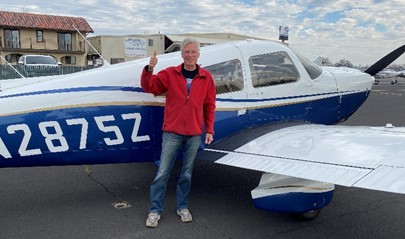
In this interview, Brink tells us about his passion for flying and gives us a candid view into his recent journey to earn his instrument rating.
Gerard: Hi Brink. Welcome! Congratulations again for earning your instrument rating. Thanks again for doing this interview. I would love to hear your story.
Brink: Happy to be here.
Gerard: Perhaps you can start by telling us a bit about yourself: who is Brink Duffy?
Brink: Well, regarding flying, it might have been in my genes. My father died a month before I was born and he was in the air force. He flew B25s. So, when I was a little boy, I became very interested in model airplanes. I would build them and fly them. Then I would get into more complex balsawood. So I always really liked airplanes, and then when I was 15 or 16, I saw this ad for gliders in Calistoga. I drove down there, and I was watching them take off. It just fascinated me. I inquired and I started taking lessons and got my private pilot for gliders when I was 18. I flew gliders there pretty consistently for four years and then life happened, and I got out of that for a while. I could not afford it, but hang gliding started being a big thing down the coast, so, I bought myself a hang glider for $400. It was a little company called Manta and they built hang gliders. Very simple, with a 3:1 glide ratio….
Gerard: That’s almost falling straight down…
Brink: I know. But the dunes at Dillon Beach were perfect. You had sea breeze that was steady. It was a 300-foot dune. You would run off the top of that, get maybe 100 ft in the air and you would get a little one-minute fight. I loved doing that. In fact, I loved just doing the takeoff and landing, just taking off on your feet. Weight shift to steer. It is probably the closest you can come to feeling like a bird.
So, fast forward to about 10 years ago: I’m in business, I’ve hired a guy and we got talking about gliding and hang gliding and he says: hey, I own a little Cessna out here at (Sacramento) Executive, and you should go flying with me. So, I did, and he let me take the controls, and that was fun.
And he kept nudging me and said that I should add my power to my glider certificate. And I said: well, I don’t know, but we kept flying. Eventually, I decided: why not, and I hired a part time instructor he recommended, and we flew out of Executive and then I got my private rating. I failed my first check ride on my short field landing. But I liked the examiner, he gave me some good tips, and I practiced and nailed the short field landing on the second attempt – perfectly on the center line. The examiner told me he appreciated that I had done a lot of practice. He said a lot of people come back and I know they haven’t practiced what I told them to do, but you’ve nailed it. Congratulations.
So now here I am. I thought about getting an instrument rating for the past 5 years, and I would get started and study, got halfway through the materials and life happened, grandkids mostly. Too many Disney land trips…
I got interrupted and forgot what I learned, picked it up again and got the rust off, but this last time, after four or five attempts, I just said: I am just going to sit down and study and at least get through the written test.
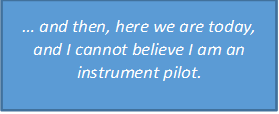
And I did, and then here we are today, and I cannot believe I am an instrument pilot. It was extremely hard!
Gerard: OK, so what are some of your best flying experiences in your flying career. Like, the top three things that you would say: these were the best things ever?
Brink: Well, I did one trip to Hollister and stayed with a friend there for a couple of days, and then on the way back, it was patchy clouds. I could not leave in the morning and I thought I could not get out today. But then it started breaking up and I saw some nice big holes, so we took off, and we circled and got above the cloud layer. And it was just a spectacular view. We did it towards the evening, and we were a couple thousand feet above the cloud layer, and it was all clear in Lincoln and a few miles to the East, so I felt comfortable. But yea, we both just enjoyed the view. The sun was shining through these cloud layers off towards the ocean. I was a little apprehensive, because usually I am flying in clear skies, so this is where I pushed it a little bit, thinking: I hope I don’t get stuck on top…, but it just felt great as an accomplishment and it was just a beautiful flight.
Gerard: It is beautiful to fly closer to clouds, and of course now you don’t have to be as worried to be closer to them or getting stuck. Even if you are not planning to go into the clouds, flying between them or close to them becomes a lot easier.
Brink: yes, that was one of the reasons for an instrument rating. Pick a place like Monterey, and it can be great weather, but there can be a little cloud layer, and if you just have the rating, you can go down through that. It opens up possibilities.
Gerard: Yes, and that leads to the next question: you are in California, look at how sunny it is again, so getting an instrument rating in California, what are the big reasons to do that?
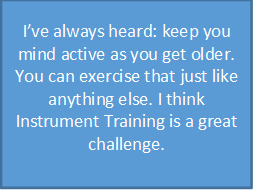
Brink: To me, one of the big reasons was the challenge of doing it. OK, I’m going to be 68 next month and, you know, we’re at the age where my wife and I are starting to finish each other’s sentences, because the word doesn’t come. So that was a big challenge for me memory-wise. There are a lot of things you have to remember.
Fortunately, I can continue to fly because the FAA requires checklists. If they didn’t require checklists and demanded that you memorize everything, I don’t know that I’d be that inclined to do this. But the memory still works, and I’ve always heard: keep your mind active as you get older. You can exercise that just like anything else. I think Instrument Training is a great challenge. There were times when I got frustrated. But then I would just get more determined! I am going to accomplish this if for no other reason then just to do it!
Gerard: as you were doing it, were there any things you learned that were a surprise to you?
Brink: yea, getting back in my Cessna: I have flown that for ten years, and I’ve gotten very good at different types of landings. So, I felt like I was a really precise pilot. You tell me where to land, and I will land it not within 200 ft, I will land within 100 ft or less. And I practiced emergency procedures. I would take the airplane up – of course I could only do this in a 150 with me as a single pilot – I would pull the power at 700 ft, do the impossible turn back to the airport and I would practice that several times, to where that didn’t worry me at all. So, I thought I was quite accomplished. Then I get into instrument and I find: no, you are not as accomplished as you thought. You actually fly quite sloppily. Because I never look at the instruments. Fly by the seat of my pants. I mean, if I go on a cross country, I will maintain my altitude probably plus or minus 200 ft. But yea, on a landing, my landings were not really that precise. I was not on an established glide path. But again, I come from a point where I can land anywhere. I might turn in real early and come in on a really steep approach and land on a pinpoint, but… again, if you told me to get on an established glide path, I never really practiced that. So that was interesting, when I tried that in the Cessna, I noticed: wow, this plane can be flown quite precisely. I never correlated power against speed for performance. So that is the biggest thing: how precise you can set up even a Cessna 150.
Gerard: What were some of the hardest things to learn? You talked a bit about checklists and memory items. What other things were hard as part of instrument training?
Brink: again, for me – and I think it is my age and memory – the hardest thing for me is not only memorizing particular tasks but getting the tasks in the proper order and staying ahead of the aircraft. You can even have a checklist for that, which I finally established my own. But I found just knowing what to do next, required constant practice on my sim and in the air before I finally had a smooth flow with no brain freezes. As far as a particular skill? I had to do a lot of practice for precision approaches and RNAV “precision approaches” – of course RNAV isn’t technically a precision approach – the LPV approach I should say. I practiced a lot on my sim. That really helped. And, in fact, pretty late, you caught me not watching the proper instrument. I would not focus on the right instrument, and I would start off well established, but as I was getting closer to the runway and things would get more sensitive, I would start overcorrecting. And we just noticed I was not looking at the attitude indicator and was just looking at other instruments and chasing those. That was probably the hardest skill.
Gerard: I remember when I was getting my instrument rating, and I hate to say it, but I was probably about half your age when I did it, and yet, my sense was: I’m 35 years old, and I’m learning a real new skill that I couldn’t do before and that I can do now. And I was asking myself: how often does that still happen in adult life. That you actually learn something completely new. That to me was the big eye opener. It is so different from everything else we are doing.
Brink: it is amazingly different. Especially going into real IMC. I often thought of it as playing a video game with serious consequences. Because you are just looking at all these dials, but if you do it wrong….
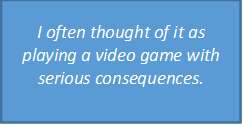
Gerard: We talked about the hardest part, so what was the most fun during the journey of getting your instrument rating?
Brink: Most fun was when we went into real IMC. That was magical. There is something about going into a cloud, being above it, dropping down into it, or coming into it from below…. One of our first flights, we were just between cloud layers or just on top, and I think I have heard the term ‘cloud surfing’. We were just going through them, and I had my hood on, but I was kind-of taking peeks, kind-of cheating a little bit, as I could see the little wispy clouds going by. I think that is fun.
But I would say both in practice and on the simulator, I really enjoyed learning the precision approach. The first time I tried it on the simulator I set it to minimums, so I had 200ft ceiling, and I am chasing these needles, wide swings one way and the other, and I finally break out of these clouds and I’m two thirds down the runway. I landed and crashed through a fence and ended up in a building. And I thought: how can you possibly learn this? And I was thinking: this simulator cannot be all that accurate. Anyway, I kept trying that and I finally got into a real airplane and then I thought: hey, I can try it in my Cessna. Then I went back to the sim, and then lots of practice. In fact, I remembered that the hardest thing I learned to do as a kid is learn how to ride a unicycle. And that, the first time you put that between your legs and try to sit on it, you think: there is no way you can learn to do this. So, I felt kind-of a similarity there. The first time you try it, you feel: it cannot be done. But again, like the unicycle, lots of practice, and eventually it just starts dialing in. So, I found that to be fun.
Gerard: So, what is next for you? You now have an instrument rating and can do almost anything with your airplane now.
Brink: I just like doing these things. I just will continue to practice instrument approaches on the sim. Keep practicing with an instructor. In fact, now what I would like to do is find IFR days and if I can call you at the last minute and ask: are you free, can we go up. My personal minimums are 1000 ft and 3 miles visibility, but if we have a day with 400 ft ceilings, I would like to go up with an instructor and do a real ILS approach in those conditions.
Of course, I’m going to take my grandkids when we have days that are within my minimums. I am going to go down to Monterey and see if we can get through a cloud layer there. And, of course, I love to fly, I love keeping my mind active. And, my next airplane is ‘complex’, in the club, and I want to start working on that one.
Gerard: yes, get the Mooney up. Alright, so, if you had to give one piece of advice to private pilots who are considering an instrument rating, what would it be?
Brink: I would say: definitely do it! Because even if you think you are not going to fly in instrument conditions, it makes you a much better pilot. And, for me, I am all about safety. I fly my grandkids here and there. I want to be as safe as possible.
The confidence that it gives you…. As a private pilot, say we flew to Monterey, I would be a little concerned about that cloud layer and I would not fly if it looked like it would not burn off.
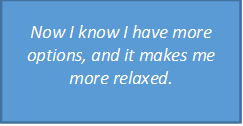
Or just flying anywhere and the weather turns out not as predicted, and we now have to divert, it just adds stress to the flying. Now I know I have more options, and it makes me more relaxed. I still will probably pick good VFR days when I am taking the grandkids. But it gives you that extra layer of confidence, makes you a better pilot.
But the advice I would give you about learning if you are ‘old’: don’t give up. It is really hard to do. If I were young and had better memory it would have gone a little faster. I got frustrated a couple of times. But just push through. It is worth it.
Gerard: Great, thank you for sharing your story with us. Congratulations again!
Are you interested in a personalized approach to pilot training? Contact us or make an appointment for a no obligation conversation.